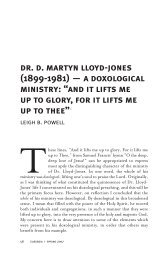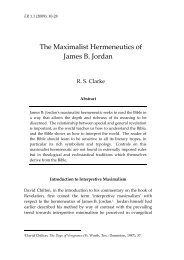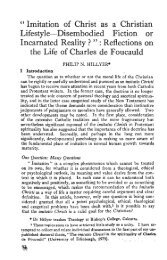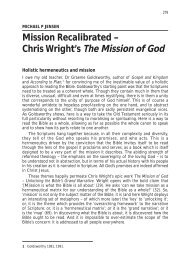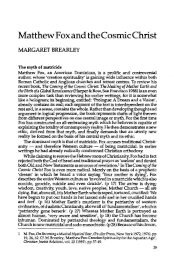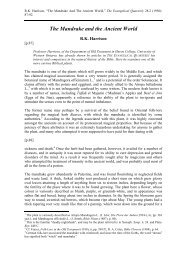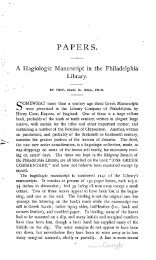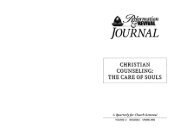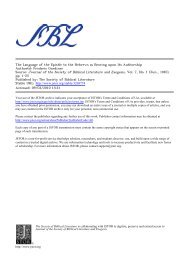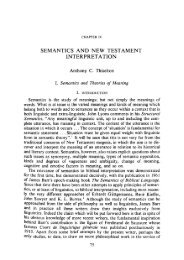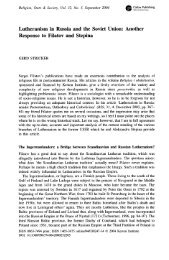Ancient Orient and Old Testament - BiblicalStudies.org.uk
Ancient Orient and Old Testament - BiblicalStudies.org.uk
Ancient Orient and Old Testament - BiblicalStudies.org.uk
You also want an ePaper? Increase the reach of your titles
YUMPU automatically turns print PDFs into web optimized ePapers that Google loves.
K.A. Kitchen, <strong>Ancient</strong> <strong>Orient</strong> <strong>and</strong> <strong>Old</strong> <strong>Testament</strong>. London: Inter-Varsity Press, 1966. Hbk. pp.191.<br />
crops of grain (Gn. 26:12; 37:7), their activities there would best fit the Middle Bronze Age I period,<br />
c. 2100-1800 BC, 72 considering their need of assured water sup-<br />
[p.50]<br />
plies <strong>and</strong> pasture or fodder for their livestock (especially as sojourners <strong>and</strong> not just passing<br />
straight through the area).<br />
4. Freedom <strong>and</strong> wide scope of travel is particularly evident in the <strong>Old</strong> Babylonian period. 73 In<br />
the Mari archives, envoys <strong>and</strong> others cross-cross the whole Near East from Hazor in Palestine<br />
to Elam in the far south-east, 74 while earlier still we have record not only of innumerable<br />
merchant caravans but also of detailed ‘itineraries’ all the way from Babylon or Assur into the<br />
heart of Asia Minor. 75 And as Abraham in Palestine was prepared to send all the way for his<br />
son’s wife to North Mesopotamian Harran, so similarly we find Shamshi-Adad I of Assyria<br />
sending to the King of Qatna in Syria for the same purpose. 76 Semi-nomadic tribes ranged far<br />
<strong>and</strong> wide 77 , <strong>and</strong> sometimes took to crop-cultivation <strong>and</strong> more settled life. 78<br />
5. The religion of the Patriarchs included prominently the concept of the ‘God of the fathers’,<br />
first stressed by Alt. 79 However, the best parallels for this come not from his Nabataean<br />
examples (about 2,000 years later) but, as Albright <strong>and</strong> Cross have pointed out, 80 from the <strong>Old</strong><br />
Assyrian tablets of the nine-<br />
[p.51]<br />
teenth century BC from Cappadocia as noted by Lewy. 81 There is no evidence that the different<br />
designations, ‘the God of Abraham’, ‘the Fear 82 of Isaac’, ‘the Mighty One of Jacob’, were<br />
72 On the date, see Albright, BASOR 163 (1961), pp. 38-40 (in agreement with Glueck, e.g. in BASOR 152<br />
(1958), p. 20, or Rivers in the Desert, 1959, p. 68). Noth’s date of the twenty-first-twentieth centuries BC (VTS,<br />
VII, p. 266) thus ends a century too early, <strong>and</strong> hence he exaggerates unwittingly the supposed divergence<br />
between this <strong>and</strong> other data, e.g. Nuzi.<br />
73 Cf. latterly the remark by A. L. Oppenheim, <strong>Ancient</strong> Mesopotamia, 1964, p. 120, top.<br />
74 ARMT, I-VI, passim; e.g., ARMT, VI, Letters 14, 15, 23, 78, ARMT, XIII, Letter 46, On Elam <strong>and</strong> the West,<br />
cf. pp. 45 f. <strong>and</strong> note 51, above, plus ARMT, XIII, Letters 31, 32.<br />
75 For the itineraries, see A. Goetze, JCS 7 (1953), PP . 51-72; M. Falkner, AfO 18 (1957-8), pp. 1-37; W. W.<br />
Hallo <strong>and</strong> Goetze, JCS 18 (1964), pp. 57-88 114-119; P. Garelli, Les Assyriens en Cappadoce, 1963, pp. 81-<br />
125. Cf. also E. Weidner, AfO 21 (1966), 42-46, for later such data.<br />
76 See Albright, BASOR 78 (1940), p. 25, being Letter 77 in G. Dossin, ARMT, I, 1950. For other inter-dynastic<br />
marriages of Shamshi-Adad’s social level, cf. J. M. Munn-Rankin, Iraq 18 (1956), pp. 94-95.<br />
77 Cf. Kupper, Les Nomades en Mésopotamie au temps des Rois de Mari, 1957, passim, e.g. pp. 47 ff., 71, 74<br />
f., 78-81, 90 f., 96 f.<br />
78 E.g., Kupper, op. cit., p. 31; cf. G. Posener in CAH 2 , I:21 (Syria <strong>and</strong> Palestine), 1965, pp. 24-29.<br />
79 A . Alt, Der Gott der Väter, 1929; now in KS, I, 1953, pp. 1-78.<br />
80 Albright, BASOR 163 (1961), pp. 48 - 49, <strong>and</strong> F. M. Cross, HTR 55 (1962) PP. 225-259- Cf. H. Hirsch, AfO 21<br />
(1966), 56-58.<br />
81 J . Lewy, Revue de l’Histoire des Religions 110 (1934), pp. 50-55, 64-65 A similar reference occurs in<br />
ARMT, V, Letter 20, line 16, in the eighteenth century BC, as noted by J. P. Hyatt, VT 5 (1955), p. 131 <strong>and</strong> n. 4<br />
(note that the eighth-century Hittite Hieroglyphic example from Topada (after Del Medico) is illusory; cf. my<br />
Hittite Hieroglyphs, Aramaeans <strong>and</strong> Hebrew Traditions, forthcoming).<br />
82 Or possibly ‘Kinsman’? So Albright, From the Stone Age to Christianity, 1957 ed., p. 248 <strong>and</strong> n. 71.




